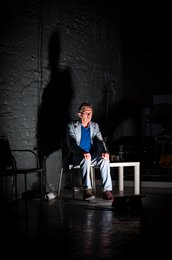Although she is best known as an established classical composer, Cork native Ailís Ní Ríain is also a writer and a playwright who has been writing texts for performance for over a decade and who often works across disciplines: her latest work, a collaborative installation piece comprising music, poetry and sculpture is currently featuring as part of the Brass: Durham International Festival. Ní Ríain’s stated artistic endeavour is to challenge, provoke and engage, and in her sound work she has worked across opera, music-theatre, electroacoustic and site-specific installation. Therefore, it should come as no surprise that she is also willing to push at the boundaries of theatre.
The Tallest Man in the World, produced by Corcadorca Theatre Company and directed by Pat Kiernan as part of the Cork Midsummer Festival 2013, is effectively a play for voices, or, it could be suggested, a play as vehicle for language and words. Although it features three characters – Eamon, the tallest man in the world (Tadgh Hickey), Erin (George Hanover) and Phelim, Erin’s father (Daniel Reardon) – and a loose narrative structure – Erin is searching for the tallest man in the world who, she believes, is her father, while the actual tallest man in the world has loved her for a long time – this is a piece of writing that, poetic in form and at heart, is performed for the listener, rather than the observer.
And if an audience shall that listener be, then much of this piece of work is a delight. Time and again over its sixty-minute duration, I noted down words, sentences, language structures that came spilling from the actors’ mouths. Sentences such as: “As I fall away from myself and into him,” or the realisation of one character that there was “no future in her indolent eyes,” or indeed Erin’s declaration that she “tied a rope to the scrawny leg of a broken bird and watched him limp away” have an aching beauty to them, and herald Ní Ríain in as an artist who knows and loves the possibilities of language. More so, Ní Ríain the composer also understands the textures and rhythms of language: here the actors operate almost as instruments, their words riffing amongst all three, sound woven upon sound, at some points the group speaks in chorus and as one.

In interviews Ní Ríain has been clear that the primary focus of the work is on the language and on the timbre and rhythm of the language, and received as such, effectively as a long narrative poem, with tumbling, oozing, sensuous, powerful language, there is much to savour in the work. Nonetheless, a narrated poem, presented within the context of a piece of theatre, has its own difficulties, primarily the difficulty of easily coming to terms with what it is the playwright has to say. This is not necessarily a criticism: after all, many of Beckett’s plays remain impenetrable upon first viewing, and it is only later that they begin slowly to permeate. However, just as language can be used to elucidate, it can also obscure, and beautifully put-together as Ní Ríain’s constructions are, I wasn’t always clear where she was going with them: the play
appeared to be some sort of meditation on what human beings will do in order to survive, but it wasn’t necessarily easy to get to the raw heart of that discussion, with form and language sometimes getting in the way.
Moreover, especially in Beckett’s longer works for theatre, there is an inherent physicality that, by its absence in this piece of work (the actors remain seated throughout), puts a strain on the language that is hard to sustain over an hour. Although Kiernan does encourage inflection, expression, emotion from the actors, the lack of movement, the lack of something happening in front of you on the stage does, after a time, become somewhat hard to bear. Had the piece been shorter, as in many of Beckett’s most experimental pieces of theatre, I suspect this may have been less of an issue, because the first twenty minutes or so of the piece feels fresh, interesting and exciting. It is only after that the form begins to wear. How would such a piece have worked for radio? Hard to say, but the focus on the voice and language does suggest it would have significant resonance had it been performed for that medium.
Nonetheless, in what is often a conservative era for theatre and other forms of writing, Ní Ríain’s piece suggests a thoughtful, intelligent and above all brave artistic voice and I, for one, look forward to seeing what she does next.
Rachel Andrews is an arts journalist and critic based in Cork.